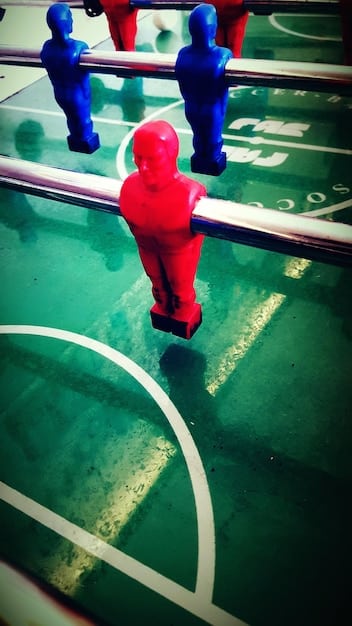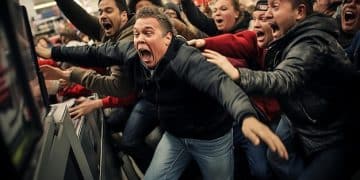King’s League USA: How Coaching Changes Affect Team Standings

Coaching changes in the King’s League USA can significantly impact team performance and league standings, influencing strategy, player morale, and overall team dynamics.
The King’s League USA is known for its dynamic gameplay and passionate fans. A key element that can dramatically shift team performance and, consequently, league standings is the change in coaching staff. Let’s explore the impact of King’s League USA: The Impact of Coaching Changes on Team Performance and League Standings.
Understanding the Dynamics of King’s League USA
The King’s League USA is not just about individual player skill; it’s a chess match where strategy and leadership play crucial roles. This segment explores what makes the King’s League USA unique and competitive.
The Significance of Strategy in the King’s League
In the King’s League USA, a well-thought-out strategy can often trump raw talent. Coaches are pivotal in devising these strategies, adapting to opponents, and maximizing their team’s potential. The ability to analyze the game and make real-time adjustments is what separates good coaches from great ones.
The Role of Team Chemistry and Morale
Beyond strategy, a coach is also responsible for fostering team chemistry and maintaining morale. A motivated and cohesive team is more likely to perform well, especially under pressure. Coaches who can effectively communicate and build strong relationships with their players often see improved results on the field.
King’s League USA embodies competition and strategic depth. A new coach brings fresh ideas and perspectives, impacting players and team dynamics. The blend of individual talent, strategic planning, and team collaboration defines success, affecting the league standings.

Why Teams Opt for Coaching Changes
Coaching changes are often a last resort, made when teams are underperforming or seeking a new direction. This segment explores the common reasons behind these decisions.
Teams in the King’s League USA may opt for coaching changes for many reasons. Here are a few:
- Poor performance: Consistent losses or failure to meet expectations often lead to a change in leadership.
- Strategic differences: Disagreements between the coach and management regarding team strategy and player selection can trigger a change.
- Cultural shift: A new coach might be brought in to create a different team culture or improve player morale.
- Competitive Edge: Sometimes, a change is made simply to introduce new ideas and strategies to gain an advantage over rivals.
Coaching changes in King’s League USA stem from multifaceted issues. Poor season performances, strategic discord, or the need for cultural renovation are primary drivers. The need to rejuvenate teams, foster innovation, and boost morale leads to coaching adjustments.
Immediate Impact on Team Performance
A new coach can bring about immediate changes in team performance, both positive and negative. This section explores what these changes might look like.
The “New Coach Bounce”
One common phenomenon is the “new coach bounce,” where a team experiences a short-term improvement in performance following a coaching change. This can be attributed to several factors, including renewed motivation among players, altered game plans, and the element of surprise that a new coach brings. However, this bounce is not always sustainable.
Potential Disruptions and Challenges
While a new coach can inject fresh energy into a team, there can also be disruptions. Players may need time to adapt to new strategies, and the team’s chemistry could be affected, especially if the coach makes significant changes to the lineup. Overcoming these challenges is crucial for long-term success.
The arrival of a new coach is a pivotal moment for any team in King’s League USA, often triggering immediate shifts in performance. Fresh strategies, a surge in player morale, and the inherent unpredictability can inject energy into the team.
Long-Term Effects on League Standings
The true impact of a coaching change is often seen in the long term, as teams adjust to new leadership and strategies. This section discusses the long-term effects on league standings. Changes to team dynamics require time to integrate completely.

Coaching changes can set teams on differing trajectories. The long-term effect can range from the team falling in the standings, remaining stagnant in the same place, or rising in the standings with the right adjustment after the change. Here are factors that play into it:
- Consistency: Sustained success depends on the coach’s ability to implement long-term strategies and maintain a consistent level of performance.
- Player development: Coaches who can develop players’ skills and integrate them effectively into the team are more likely to achieve lasting success.
- Adaptability: The ability to adapt to changing circumstances, such as injuries or shifts in the competitive landscape, is essential for maintaining a strong position in the league standings.
Coaching transitions in King’s League USA yield lasting effects. Team dynamics, strategies, consistency, player growth, adaptability, and recruitment all contribute to lasting changes in standings. Sustainable performance hinges on coaches’ skills, communication, and ability to make informed decisions.
Case Studies: Successful and Unsuccessful Coaching Changes
Examining real-world examples can provide valuable insights into the impact of coaching changes. This section presents case studies of both successful and unsuccessful transitions.
Analyzing Success Stories
There have been numerous cases in King’s League USA where a coaching change has led to a significant turnaround in a team’s fortunes. These success stories often involve coaches who were able to quickly assess the team’s strengths and weaknesses, implement effective strategies, and motivate players to perform at their best.
Learning from Failures
On the other hand, there are also examples of coaching changes that did not yield the desired results. These failures often stem from a lack of strategic alignment, poor communication, or an inability to adapt to the team’s existing culture. Examining these cases can help teams avoid similar pitfalls in the future.
King’s League USA coaching changes offer profound lessons. Success stories often reveal the power of strategic alignment and motivational transformations. Observing unsuccessful changes highlights misalignment, poor communication, and a failure to adapt to team culture.
Factors Influencing Coaching Change Outcomes
Several factors can influence the outcome of a coaching change, from the timing of the decision to the coach’s fit with the team. This section explores these factors.
- Timing: Making a change mid-season can disrupt team chemistry, while waiting until the off-season allows for a more seamless transition.
- Coach-player fit: A coach’s personality and coaching style must align with the team’s culture and player preferences.
- Support from management: Coaches need the full support of team management to implement their strategies effectively.
- Resources: Access to adequate resources, such as training facilities and support staff, can significantly impact a coach’s ability to succeed.
The success of coaching changes depends on careful navigation of various factors. Timing, alignment between coach and players, support from team leaders, and available resources influence outcomes. A blend of strategic judgment and effective communication shapes the impact of coaching decisions within the league.
| Key Point | Brief Description |
|---|---|
| 🔄 Impact of Timing | Mid-season changes can disrupt, while off-season allows smoother transitions. |
| 🤝 Coach-Player Fit | Alignment of coach’s style with team culture is crucial. |
| 🌟 Leadership Morale | A coach can either build or break a team’s morale. |
| 🛠️ Strategic Adaptability | Adjusting plans based on opponents is vital for success. |
Frequently Asked Questions
▼
A new coach can sometimes create an immediate impact through a “new coach bounce,” where the team sees short-term improvements due to fresh strategies and renewed player motivation.
▼
Success depends on several factors, including the coach’s ability to connect with players, implement effective strategies, and adapt to the team’s and league’s unique dynamics.
▼
Yes, if the players struggle to adapt to the new strategies, or if the coach’s style clashes with the team’s culture, it can disrupt team chemistry and hurt performance.
▼
The timing is crucial; a mid-season change can disrupt team dynamics, while an off-season change allows more time for adaptation and strategy implementation, often aiding in a smoother transition.
▼
Access to training facilities, support staff, and other resources significantly impact a coach’s ability to implement strategies and ultimately improve the team’s overall performance and competitive edge.
Conclusion
In the dynamic framework of the King’s League USA, coaching transitions emerge as potent catalysts for change, adept at reshaping team morale, strategy, and, ultimately, league positions. Understanding the factors that promote successful shifts and learning from unsuccessful attempts can benefit teams seeking progress. Careful thought and planning are key to optimizing a coaching improvement.





